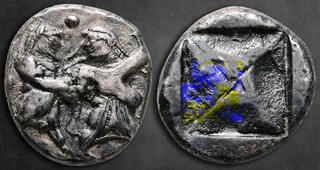| Savoca Numismatik GmbH & Co. KG > Online Auction 193 | Silver | Auction date: 28 January 2024 |
| Lot number: 27 Price realized: 1,500 EUR (Approx. 1,625 USD) Note: Prices do not include buyer's fees. | Show similar lots on CoinArchives Find similar lots in upcoming auctions on |
| Lot description: Thraco-Macedonian Region. Berge, Previously identified as either Lete or Siris circa 525-480 BC. Stater AR 22 mm, 9,80 g Ithyphallic satyr standing to right, grasping wrist of nymph fleeing to right, head reverted; pellet above and to left / Irregular quadripartite incuse square, diagonally divided. Pleasantly toned, well centred, Good Very Fine. Smith Group 5 (Lete); Peykov A0020; cf. SNG ANS 945-65 ('Lete'); HPM pl. VIII, 1-10 (Siris); HGC 3.1, 531 ('Lete'). The history of the stater coins from Berge, previously attributed to Lete or Siris, presents a fascinating chapter in the narrative of ancient Greek coinage. These coins are renowned for their distinctive and provocative imagery featuring a thyphallic satyr and a fleeing nymph, a motif rich in mythological and cultural significance. Crafted in the classical period, these coins exhibit the exceptional artistry of the ancient Greek world. On one side, they depict a raw and dynamic scene: a satyr, characterized by his exaggerated, thyphallic form, is in pursuit of a nymph. The satyr, a creature often associated with Dionysus, the god of wine and ecstasy, is shown standing to the right, his hand grasping the wrist of the nymph who is fleeing to the right, her head turned back. The scene captures a moment of intense drama and emotion, reflective of the themes common in Greek mythology and art. Above and to the left of this vivid portrayal, a small pellet is present. The inclusion of this detail, while seemingly minor, is a testament to the meticulous craftsmanship of the coin makers. It adds a sense of balance to the composition and may carry symbolic meaning, perhaps related to the celestial or natural elements in ancient Greek mythology. Initially, these staters were attributed to the cities of Lete or Siris, but later research and findings shifted this attribution to the city of Berge. This reattribution is a common occurrence in numismatic studies, where ongoing research and discoveries continually refine our understanding of ancient coinage. The imagery on these coins is not just an artistic expression but also a reflection of the religious and cultural beliefs of the time. The depiction of satyrs and nymphs was common in Greek mythology, symbolizing the primal and untamed aspects of nature and humanity. These themes were widely explored in various forms of Greek art and literature, resonating with the ancient Greeks' understanding of the world around them. In summary, the staters from Berge, with their depiction of the thyphallic satyr and the fleeing nymph, provide a striking example of the rich symbolic and artistic tradition of ancient Greek coinage. They encapsulate the complexities of Greek mythology and the exceptional skill of ancient coin artisans, making them a subject of enduring fascination in the study of ancient numismatics Starting price: 1500 EUR |  |


